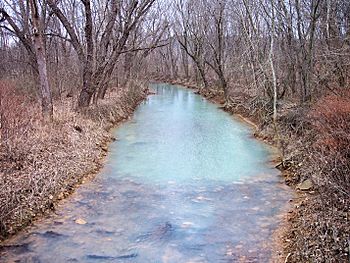Monday Creek facts for kids
Quick facts for kids Monday Creek |
|
|---|---|

Monday Creek near Nelsonville in 2006
|
|
| Country | United States |
| State | Ohio |
| Counties | Perry, Hocking, Athens |
| Physical characteristics | |
| Main source | Perry County, Ohio, approximately 2 mi (3 km) north of Shawnee Approx. 820 ft (250 m) 39°37′48″N 82°11′54″W / 39.63000°N 82.19833°W |
| River mouth | Hocking River in Athens County, Ohio, approximately 2 mi (3.2 km) southeast of Nelsonville 659 ft (201 m) 39°25′01″N 82°11′34″W / 39.41694°N 82.19278°W |
| Length | 27.0 mi (43.5 km) |
| Basin features | |
| Basin size | 116 sq mi (300 km2) |
Monday Creek is a stream in southeastern Ohio, United States. It flows into the Hocking River and is about 27 miles (43.5 km) long. The Hocking River then flows into the Ohio River, which eventually joins the Mississippi River. This means Monday Creek is part of the huge watershed of the Mississippi River. It drains an area of 116 square miles (300 km²) in a hilly region called the Allegheny Plateau. Sadly, Monday Creek has been seriously harmed by pollution from old mines, known as acid mine drainage.
Contents
Where Monday Creek Flows
Monday Creek starts north of Shawnee in Perry County. It flows generally south through parts of Hocking County and Athens County. The creek passes through the eastern side of Nelsonville. It then meets the Hocking River about 2 miles (3 km) southeast of Nelsonville.
Two important smaller streams join Monday Creek:
- Little Monday Creek is about 14.3 miles (23 km) long. It flows through Perry and Hocking Counties.
- Snow Fork is about 10.7 miles (17.2 km) long. It starts in Perry County and flows through Hocking and Athens Counties, passing through towns like Murray City and Buchtel.
Most of the land around Monday Creek is covered by forests, about 87%. A small part, about 5%, was used for surface mining. Other uses include farms, wetlands, and areas for grazing animals. The Wayne National Forest owns a big part of the land in the Monday Creek area, about 38%.
A Look at Monday Creek's Past
The Adena people were the first known residents of the Monday Creek area around 1000 BC. Later, other Native American groups, like the Lenape, Shawnee, and Wyandot, lived here.
A story says that early European explorers named the stream "Monday Creek" because they found it on a Monday. The day before, they had named a nearby stream "Sunday Creek" for the same reason. The first European settlements in the area began in 1774. The Ohio Company bought all the land in the Monday Creek watershed in the late 1700s.
How Mining Changed the Creek
From the mid-1800s to the mid-1900s, people heavily used the natural resources around Monday Creek. They dug for coal, cut down trees for timber, and mined for salt, iron, and clay. This had a big impact on the environment.
- Iron: Iron made in this area helped the North during the Civil War.
- Forests: By 1885, almost 90% of the Monday Creek area was deforested, meaning most of the trees were cut down. Replanting started when the Wayne National Forest was created in 1935.
- Other Resources: Salt was mined in the 1800s. Clay was used to make bricks, with production peaking in the early 1900s. Oil and natural gas production began in 1909.
The first coal mines in the area started in the 1860s. These early mines were underground. This type of mining decreased by the 1920s and completely stopped by 1991. Surface mining began after World War II but also declined by the 1970s. The coal found here has a lot of sulfur, which can cause pollution.
Pollution and Restoration Efforts
The Ohio Environmental Protection Agency (EPA) has stated that Monday Creek has been "irretrievably altered." This means it has been changed so much that almost no aquatic life (fish and other water creatures) can live there. This severe damage is due to acid mine drainage. This type of pollution happens when water flows through old mines and picks up harmful chemicals, making the water very acidic.
Since 1994, a group called Rural Action has been working on the Monday Creek Restoration Project. They are trying to fix the water quality problems in the Monday Creek watershed and bring the creek back to health.


